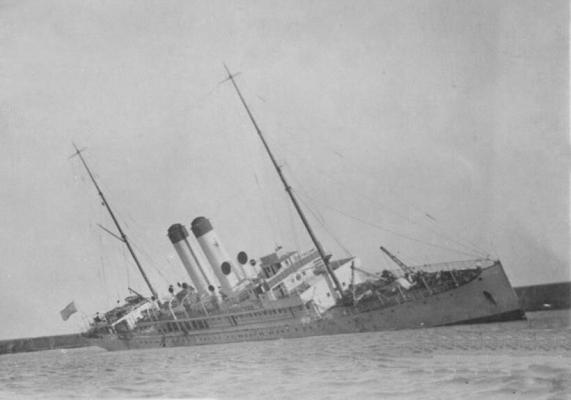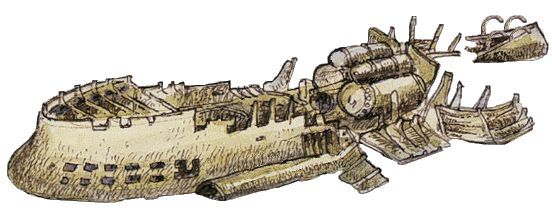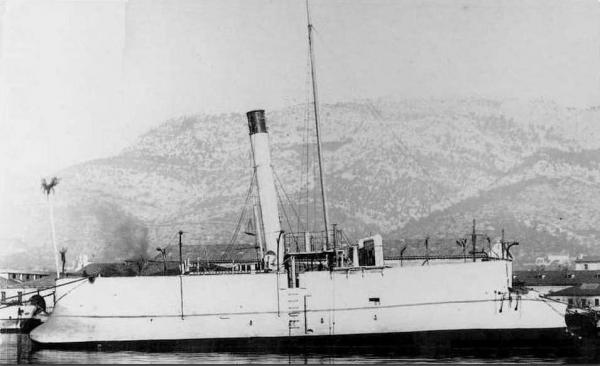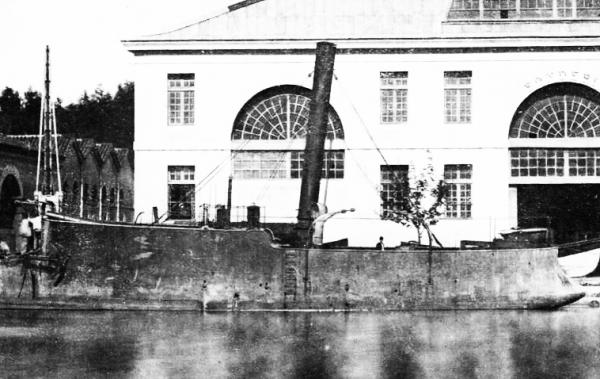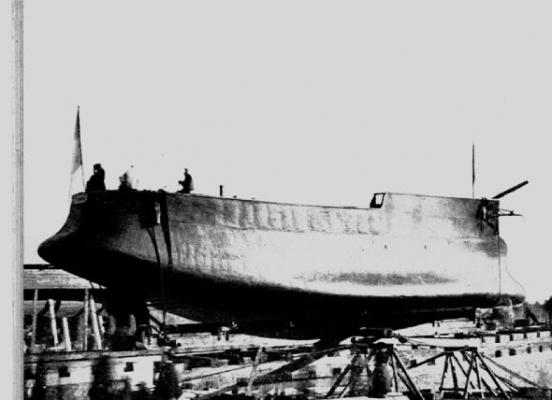-
Posts
250 -
Joined
-
Last visited
Content Type
Profiles
Forums
Gallery
Events
Everything posted by Doreltomin
-
Hmmm... still nothing? Maybe I should add another clue? How about the fact that the name of the ship relates to a character from the Ancient Rome?
-
Quite normal in fact, this is the typical rig on most period Navy Board Models. Or at least those which have any rig at all, because most of them have no rig or have only the typical launch apparel instead (a suite of big flags). The idea behind this is the fact that: a) no matter how fine the cloth you use, it is much too coarse if considered reduced to scale for your model. So if you want a "true" appearance for your model, better show it without sails. sails weren't a permanent fixture on their masts, nor were all the parts of the rigging set all the time except when going on a high sea with all sails set. As many period drawing shows, with ships in harbour many parts of the rigging were dismantled and stowed in the hold or on the deck, sometimes even the upper parts of the masts. This was especially true for the pieces of canvas which were costly and fragile, could get damp and rot quickly, so any experienced skipper knew that the first thing to do when in port is to get your sails dried then take them off and put them in storage in a dry and ventilated area. An observation though with the above picture(s): if the model is presented without sails, then the yards of the upper sails must be presented in the lowered position. Except the yards of the main sails which were fixed, all the upper sail yards were mobile (could go up and down their mast segment) and were raised in the upper position only when carrying a sail on them!
-
Hello all, @George, don't bother with the flag, I said previously that I have tampered with two easy key-points of identification: the flag and the name written high on the bulwark. Better think of the ship architecture, which will eventually led you into which period, who built the ship and for which company. Also, don't forget the clues: she had another sister-ship and were both connected to a train - certainly NOT in the Baltic! And by the way, she never heard German in her life (except for some German passenger, of course) neither when built, nor when she was in service. On the contrary, she always was in the opposite side with the German-speaking world, Swiss not taken into account, of course, as they always have been neutral and have no battle fleet @Jud, the same for me, I see this game in its utmost sense as a wonderful opportunity to learn stories about ships. We come from different corners of the world and what may be familiar for me is not familiar for you so it's a good opportunity to share naval stories and learn more about our pet subject!
-
My pleasure, Jan, as always! Now can we return to our sheep.... oops... nobody? did I kill the game? May be of interest for you to know that she had another sister, and she was somehow related to the route of a train?
-
Actually I believe if your admiral thinks a bit, she would be happy to have you at home close to her working at your little boat, instead of being away from home and having a beer with the friends, not to mention the risk of enjoying the gracious company of other ladies! Now your Puritan looks great and I am sure will be a very nice build, much more appropriate for a first build than a Constitution, a Victory or a Wasa!
-
Hello Jan, no, it's not the SS Maheno.. you are actually quite far from her. As for the extreme look of some French ships, without making a very long history here, you must think of the peculiar situation in which the French marine was after Trafalgar. The English were the masters of the sea in all respects while the French were forced to play the game in the second league. It's not a surprise therefore that the English Admiralty were crippled in the old fashioned ways of thinking, being the victims of their own success, while the French were defeated and therefore the new generations of officers were anxious to explore new ways. This was the Nouvelle ecole (New School) which during the 19th century explored ship shapes and technical solutions which, if successful, could bring France back in the premier league. The extreme tumble-home was thought at the time to have two advantages: one was that the bulging underwater hull could give a greater stability, the second was making ship boarding more difficult.
-
Hello captain Slog, indeed, there were three in this class, the Tonnerre the Tempête and the Fulminant which are very difficult to make the difference between as they were all alike. At least, I am not able to make any difference between them, so thank you for allowing just the class to be recognized and not the ship herself. Actually when going with French ships you ventured into a territory which is well known to me: since a youngster it happened to have in my library a big beautiful book called "Historie de la Marine française illustree" by Ronciere & Clerc-Rampal, Paris 1934. This inspired me to further research into the wonderful world of 19th century French warship beasts. These are indeed second to none when comes to bizarre and sometimes ugly appearance! We now turn to the next mystery photo. Please note that for the beginning I have tampered with the picture and erased all the obvious features like the name or the flag. Also, I have attempted to make it less vulnerable to "image research".
-
Hello Cristiano, That's indeed a very interesting project. Now, if incidentally you have the book "Vele Italiane" by Sergio Bellabarba and Edoardo Guerreri it will help you a lot to "navigate" into the rather complex and murky waters of the Mediterranean rigs and crafts. Then, you can go to pages 178-181 where the "Pollaca" (the Polish, or polacre) is briefly presented. Although the presentation is rather short and focuses on more recent ships, at page 180 you can see a 1660's etching by Jean Jouve. I Have found the same for you on the net here: http://upload.wikimedia.org/wikipedia/commons/b/b5/Polacre_of_Jean_Jouve_2.jpg A similar one can be seen here: http://upload.wikimedia.org/wikipedia/commons/4/45/Polacre_of_Jean_Jouve_1.jpg These are French polacres but the rig is fairly similar to these belonging to other nations. As you see, the typical polacre rig comprises two lateens to the fore and the aft AND a square rig to the main. The typical feature of the polacre is the "pollacone" (or in plain English the "pole mast"): the main is made in a single piece, not in three pieces as a normal mast. I believe the original name can have something with the big trees (from which the masts were made) being imported from Poland. As for the small "windows" which puzzle you I believe are in fact gun ports. The ship may have had some galleries just above the main guns both to the fore and aft superstructures. These galleries do not cover the whole gundeck, just the guns, so that the gun crew can operate the gun normally from the deck, yet another crew can operate the smaller gun on the gallery. These were smaller guns with a simplified sleigh carriage without wheels, absorbing the recoil through friction with the deck. If the friction was too much, a bit of grease was applied! These gun galleries were common to 17th century ships but since they were not very easy to work with this was a discontinued solution into the big warships of the 18th to 18th centuries, when full developed decks were always preferred instead. Hope this helps!
-
Wow... that's indeed a strange beast... Could her be the Garde-côtes "Tonerre" (coast guard "Thunder") of Cherbourg, 1875?
-
Hello Omega, just came across your building log here. Very impressive, congratulations. I would say this is really inspiring! I particularly like the photo with the model kept in your hand. Gives a good idea on the real scale. At 1/192 scale this is TINY! Keep up the good work!
-
Hummmm... if incidentally the stem is on the right, might look like one of Rendel's flatirons!
-
http://www.all-model.com/cmb/cmb00/47.gif Hope this helps!
-
Yess... I know! it's the invisible ship!!! :D
-
Yessss, congratulations Jan! She is indeed the Tromblon of 1875, nowadays a well known diving site off Toulon. The fourth picture shows her as she is today: Your turn!
-
Yes Jan, actually I love this period very much because of these bizarre shaped ships. I remember first seeing as a school boy a picture of the old Redoutable in the Brest dry dock. It was in my first maritime book, which I kept reading and re-reading all the time. It looked like an old marine beast taken out of the sea. Now here is the first photograph of our "beast", taken late in her career, with the raised part of bulwark stripped down and extensively modified from her previous look. And it is not incidentally that I spoke of the old Redoutable, which was actually one year younger than our subject!
-
Good point, Jan! Yes!
-
Well, I believe it's time for another clue. Yes Hexnut, it's post siege of Saigon and post Crimea and Jan guessed the period pretty well, althoug he must have looked a few years earlier than 1880. And she's not a car ferry but a gunboat. Moreover, she's not one in a series but just an one-shot boat with an un-eventful career. She had only one brief episode of war in the summer of 1881. Yet, there is a twist of the tale. As previously said, she still exists... in a certain way, and is well known to those who research her. I had just four pictures of this rather bizzare craft. The first was that one on the building yard. Here you can see the second picture of her, this time floating -later in her career, with her masting and rigging stripped off and only with the funnel remaining. I believe this picture is taken during a refit because the next one shows her with just one mast before the funnel, without bowsprit and extensively modified in the fore part, which incidentally makes her ressemble well with Rendel's flatirons And, by the way: as the rake of the funnel says, the stem is to the left and the stern is to the right of the picture!
-
Hello Hexnut, she is neither the Marengo nor a floating battery, she's a two masted gunboat. Moreover, I did not use the present tense incidentally. She still exists... in a certain way. She was preserved, but in a diverse mode than those museum ships
-
Hello Jan, You got the correct country and should look several years earlier. And by the way, have you noticed the bowsprit at the right side of the picture? And there's also a rudder under the hull in the left side! @DFellingham: Actually these guys from Star Wars must have inspired themselves from somewhere and these odd looking hulls of the Nouvelle Ecole would have made good examples!
-

how to paint like this?
Doreltomin replied to luesey's topic in Painting, finishing and weathering products and techniques
Hello, you can't use an airbrush to paint such things... only hand paint with a lot of patience and skill. If you want however, you can first give it a uniform coat of paint using the airbrush. -
Hello Jan, I'm glad my little mystery stirred your interest! It is surely a ship and not just a part of her, although here she is shown in the building yard, without masts and other superstructures. Just think who pioneered such ship shapes, and when...
-
Hello all, Yes it is my turn since Spyglass said I was correct in guessing she was the Peggy. Spyglass, I am very grateful to you for pointing me this, I didn't know the history of this interesting schooner. Just imagine the surprise of that people finding the ship in the cellar, like a time capsule! We now turn to the next mystery photo. Which ship is this?
-
Hello Captain Slog, It is certainly easy to find a ship this way, yet I am very grateful to Spyglass that he pointed to us this interesting boat. I could have never known there is such a thing would he have not posted that mystery photo. Then, as I have said previously, the only answer to the "image search" scheme is to put in a mystery photo from your own collection so that Google comes with no significant result. Just wait for my next mystery and you will see
-
@Captain Slog: Actually the best part of this game is that someone points us a ship, first as a mystery photo, then in the process of finding which ship is that we find an interesting history regarding her. So googling a photo isn't frowned upon, yet all those which know it's so easy to find it that way use photos from other sources so that googling comes with no results! For instance, the mystery photo posted by our friend Spyglass shows a very interesting ship for me.. looks like 17th to 18th century... my favourite period... so where this wonder is? Later edit: I think I found her... she is the "Peggy", an armed yacht of 1791 (so I was right with 18th century haha) She was found in a cellar in 1936 an now is a key exhibit in the Castletown Maritime Museum in Manx. @Spyglass: thank you very much for pointing us this... a VERY interesting thing!
-
Nadezhda (Hope) she is indeed, congratulations Jason! A very nice looking French-built ship, I would say! Your turn!
About us
Modelshipworld - Advancing Ship Modeling through Research
SSL Secured
Your security is important for us so this Website is SSL-Secured
NRG Mailing Address
Nautical Research Guild
237 South Lincoln Street
Westmont IL, 60559-1917
Model Ship World ® and the MSW logo are Registered Trademarks, and belong to the Nautical Research Guild (United States Patent and Trademark Office: No. 6,929,264 & No. 6,929,274, registered Dec. 20, 2022)
Helpful Links
About the NRG
If you enjoy building ship models that are historically accurate as well as beautiful, then The Nautical Research Guild (NRG) is just right for you.
The Guild is a non-profit educational organization whose mission is to “Advance Ship Modeling Through Research”. We provide support to our members in their efforts to raise the quality of their model ships.
The Nautical Research Guild has published our world-renowned quarterly magazine, The Nautical Research Journal, since 1955. The pages of the Journal are full of articles by accomplished ship modelers who show you how they create those exquisite details on their models, and by maritime historians who show you the correct details to build. The Journal is available in both print and digital editions. Go to the NRG web site (www.thenrg.org) to download a complimentary digital copy of the Journal. The NRG also publishes plan sets, books and compilations of back issues of the Journal and the former Ships in Scale and Model Ship Builder magazines.



